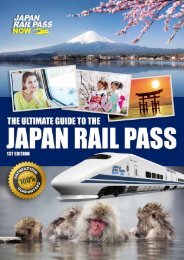Japan Rail Pass Now - Japan Travel Guide
Japan Travel Guide by Japan Rail Pass Now (www.japanrailpass.com.au)
Japan Travel Guide by Japan Rail Pass Now (www.japanrailpass.com.au)
You also want an ePaper? Increase the reach of your titles
YUMPU automatically turns print PDFs into web optimized ePapers that Google loves.
Brief History of <strong>Japan</strong><br />
Medieval Period (1185 – 1600)<br />
The Medieval era in <strong>Japan</strong>ese history lasted for more than four centuries. It consisted of the:<br />
●<br />
●<br />
●<br />
Kamakura period, the initial years of which saw the governance of Minamoto no Yoritomo, Kamakura’s first shogun, along with the rise<br />
of the samurai warriors, caste system and feudalism;<br />
Muromachi or Ashikaga period, which covered the time of the Ashikaga or Muromachi rule (headed by their first shogun, Ashikaga<br />
Takauji) up until the early years of the Sengoku or Warring States period from 1465 to 1573, when the last shogun, Ashikaga Yoshiaka<br />
was cast out of Kyoto by daimyo Oda Nobunaga; and<br />
Azuchi-Momoyama period, which covered the ruling years of Oda Nobunaga and Toyotomi Hideyoshi (1573 to 1600) and laid the<br />
foundations to the formation of the Tokugawa shogunate.<br />
Modern Period (1600 – current)<br />
The establishment of the Tokugawa shogunate signified the commencement of <strong>Japan</strong>’s modern period, which featured improvements in the<br />
overall social, political and economic stability of the country. With Tokugawa Ieyasu holding the reins, <strong>Japan</strong> became self-sustaining, utilising<br />
its resources to the maximum.<br />
In 1868, during the Boshin War, the Tokugawa shogunate fell and was replaced by the Meiji Empire, led by Emperor Meiji. During this time,<br />
<strong>Japan</strong> switched from a society that was isolated and under feudal rule into a modern one that was characterised by significant transformations<br />
in its economic, political, military, social and international affairs. It ended when Emperor Meiji died in 1912.<br />
Emperor Taisho took over the throne and was in power for 14 years, a time that was dubbed the “Taisho democracy” because of the ascent of<br />
the democratic parties into political power.<br />
Emperor Taisho’s death from a heart attack in 1926 brought in the Showa period, which shifted the <strong>Japan</strong>ese political system into ultranationalism,<br />
fascism and totalitarianism. <strong>Japan</strong> was among the many nations badly impacted by the Great Depression in the 1930s. Led by<br />
Emperor Showa, the country became a presence on the global scene, taking part in the Second Sino-<strong>Japan</strong>ese War (1937-1945) and the<br />
Second World War (1939-1945).<br />
After it was defeated in World War II, <strong>Japan</strong> was occupied by foreign rule for seven years. It underwent major restructuring in its economy and<br />
politics, particularly from being governed by an Emperor to being a democratic, constitutional monarchy.<br />
From 1989 up to the present, <strong>Japan</strong> is in the Heisei period, with Emperor Akihito on the throne. Through the years, the country has experienced<br />
huge leaps in economic progress and has gained much international recognition of its popular culture (manga, anime, video games), tourist<br />
landmarks, culture, food and history.<br />
222 - <strong>Japan</strong> <strong>Travel</strong> <strong>Guide</strong>



